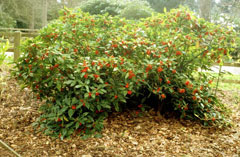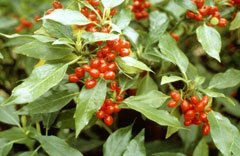 |
|
(c) 2010 Ken Fern & Plants For A Future |
 |
| (c) 2010 Ken Fern & Plants For A Future |
Translate this page:
Summary
Bloom Color: Red. Main Bloom Time: Early spring, Late spring, Mid spring. Form: Oval, Rounded, Upright or erect
Physical Characteristics

 Aucuba_japonica is an evergreen Shrub growing to 3 m (9ft) by 2.5 m (8ft) at a medium rate.
Aucuba_japonica is an evergreen Shrub growing to 3 m (9ft) by 2.5 m (8ft) at a medium rate.
See above for USDA hardiness. It is hardy to UK zone 7. It is in leaf all year, in flower from March to April, and the seeds ripen from October to February. The species is dioecious (individual flowers are either male or female, but only one sex is to be found on any one plant so both male and female plants must be grown if seed is required). . The plant is not self-fertile.
Suitable for: light (sandy), medium (loamy) and heavy (clay) soils, prefers well-drained soil and can grow in heavy clay and nutritionally poor soils. Suitable pH: mildly acid, neutral and basic (mildly alkaline) soils and can grow in very acid and very alkaline soils.
It can grow in full shade (deep woodland) semi-shade (light woodland) or no shade. It prefers dry or moist soil and can tolerate drought. The plant can tolerate maritime exposure.
It can tolerate atmospheric pollution.
UK Hardiness Map
US Hardiness Map
Synonyms
Plant Habitats
Edible Uses
Leaves - cooked. An emergency food[177]. It would have to be quite an emergency to convince me to eat them[K].
References More on Edible Uses
Medicinal Uses
Plants For A Future can not take any responsibility for any adverse effects from the use of plants. Always seek advice from a professional before using a plant medicinally.
The leaves are pounded and applied to burns, swellings, chilblains etc[218].
References More on Medicinal Uses
The Bookshop: Edible Plant Books
Our Latest books on Perennial Plants For Food Forests and Permaculture Gardens in paperback or digital formats.

Edible Tropical Plants
Food Forest Plants for Hotter Conditions: 250+ Plants For Tropical Food Forests & Permaculture Gardens.
More

Edible Temperate Plants
Plants for Your Food Forest: 500 Plants for Temperate Food Forests & Permaculture Gardens.
More

More Books
PFAF have eight books available in paperback and digital formats. Browse the shop for more information.
Shop Now
Other Uses
Makes a good hedge but its large leaves mean that it is quite labour intensive to maintain if a neatly clipped appearance is desired[29]. Unless you are happy with the large leaves being cut in half, it means that you have to trim the hedge with secateurs[29]. The plant will eventually make large weed-excluding shrubs and are suitable for covering large areas of ground, there are some dwarf forms that can be grown for ground cover[208]. 'Nana Rotundifolia' has been mentioned and will form a hummock of growth about 1 metre across[208].
Special Uses
References More on Other Uses
Cultivation details
Landscape Uses: Border, Container, Foundation, Massing, Specimen, Woodland garden. A very tolerant and easily grown plant[1], it thrives in most soils and even in the total shade of trees[11, 182, 200] though for good fruit production a position with at least moderate sun should be chosen[11]. Tolerates dry soils and drought[184, 200]. Grows well in heavy clay soils. Tolerates salt winds[200]. Very tolerant of atmospheric pollution[11]. Plants are hardy to about -15°c[184, 200]. Often grown in the ornamental garden, there are many named varieties[182]. The foliage can be scorched in very long hot summers if the plant is in an open position[200]. Very tolerant of pruning, plants can be cut right back into the old wood if required[184, 200]. Plants in this genus are notably resistant to honey fungus[200]. Dioecious. Male and female plants must be grown if seed is required. Special Features:
Attractive foliage, Not North American native, Inconspicuous flowers or blooms.
References Carbon Farming Information and Carbon Sequestration Information
Temperature Converter
Type a value in the Celsius field to convert the value to Fahrenheit:
Fahrenheit:
The PFAF Bookshop
Plants For A Future have a number of books available in paperback and digital form. Book titles include Edible Plants, Edible Perennials, Edible Trees,Edible Shrubs, Woodland Gardening, and Temperate Food Forest Plants. Our new book is Food Forest Plants For Hotter Conditions (Tropical and Sub-Tropical).
Shop Now
Plant Propagation
Seed - best sown as soon as it is ripe in a cold frame[134]. Wash off the pulpy coating since this can inhibit germination. Stored seed should be soaked overnight and then stratified for 1 - 2 weeks at 3°c[134]. The seed usually germinates in 1 - 3 months or more at 20°c[134]. When they are large enough to handle, prick the seedlings out into individual pots and grow them on in the greenhouse for at least their first winter. Once they are 20cm or more tall, plant them out into their permanent positions in late spring or early summer, after the last expected frosts. Cuttings of mature wood of the current season's growth, 15 - 20cm long outdoors at any time between September to February though October and November are best[78]. Very easy, even small branches will root[1]. Layering in autumn. Takes 12 months[78].
Other Names
If available other names are mentioned here
Native Range
TEMPERATE ASIA: China (Zhejiang Sheng), Japan (Hokkaidô, Honshu, Kyushu, Ryukyu Islands, Shikoku), Taiwan
Weed Potential
Right plant wrong place. We are currently updating this section.
Please note that a plant may be invasive in one area but may not in your area so it’s worth checking.
Conservation Status
IUCN Red List of Threatened Plants Status :

Growth: S = slow M = medium F = fast. Soil: L = light (sandy) M = medium H = heavy (clay). pH: A = acid N = neutral B = basic (alkaline). Shade: F = full shade S = semi-shade N = no shade. Moisture: D = dry M = Moist We = wet Wa = water.
Expert comment
Author
Thunb.
Botanical References
1158200
Links / References
For a list of references used on this page please go here
Readers comment
| Add a comment |
|
If you have important information about this plant that may help other users please add a comment or link below. Only comments or links that are felt to be directly relevant to a plant will be included. If you think a comment/link or information contained on this page is inaccurate or misleading we would welcome your feedback at [email protected]. If you have questions about a plant please use the Forum on this website as we do not have the resources to answer questions ourselves.
* Please note: the comments by website users are not necessarily those held by PFAF and may give misleading or inaccurate information.
To leave a comment please Register or login here All comments need to be approved so will not appear immediately.
|
Subject : Aucuba_japonica
|
|
|
|